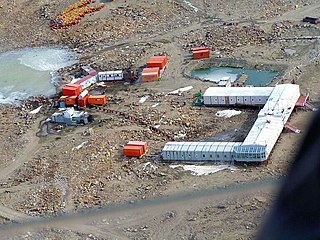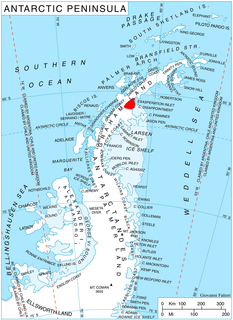
The Antarctic Treaty and related agreements, collectively known as the Antarctic Treaty System (ATS), regulate international relations with respect to Antarctica, Earth's only continent without a native human population. For the purposes of the treaty system, Antarctica is defined as all of the land and ice shelves south of 60°S latitude. The treaty entered into force in 1961 and currently has 54 parties. The treaty sets aside Antarctica as a scientific preserve, establishes freedom of scientific investigation, and bans military activity on the continent. The treaty was the first arms control agreement established during the Cold War. Since September 2004, the Antarctic Treaty Secretariat headquarters has been located in Buenos Aires, Argentina.

The Protocol on Environmental Protection to the Antarctic Treaty, also known as the Antarctic-Environmental Protocol, or the Madrid Protocol, is part of the Antarctic Treaty System. It provides for comprehensive protection of the Antarctic environment and dependent and associated ecosystems.
The Australian Antarctic Division (AAD) is a division of the Department of the Environment. The Division undertakes science programs and research projects to contribute to an understanding of Antarctica and the Southern Ocean. It conducts and supports collaborative research programs with other Australian and international organisations, such as the Bureau of Meteorology and Geoscience Australia, as well as administering and maintaining a presence in Australian Antarctic and sub-Antarctic territories.

The Australian Antarctic Territory (AAT) is a part of Antarctica administered by the Australian Antarctic Division, an agency of the federal Department of the Environment and Energy. The territory's history dates to a claim on Enderby Land made by the United Kingdom in 1841, which was subsequently expanded and eventually transferred to Australia in 1933. It is the largest territory of Antarctica claimed by any nation by area. In 1961, the Antarctic Treaty came into force. Article 4 deals with territorial claims, and although it does not renounce or diminish any preexisting claims to sovereignty, it also does not prejudice the position of Contracting Parties in their recognition or non-recognition of territorial sovereignty. As a result, only four other countries—New Zealand, the United Kingdom, France, and Norway—recognise Australia's claim to sovereignty in Antarctica.

The special territories of the European Union are 21 territories of EU member states which, for historical, geographical, or political reasons, enjoy special status within or outside the European Union. The special territories divide themselves in three categories: 9Outermost Regions (OMR) that form part of the European Union, though they benefit from derogations from some EU laws due to their geographical remoteness from mainland Europe, 13 Overseas Countries and Territories (OCT) that do not form part of the European Union, though they cooperate with the EU via the Overseas Countries and Territories Association, and 10special cases where EU law make ad hoc provisions.

The Indian Antarctic Program is a multi-disciplinary, multi-institutional program under the control of the National Centre for Polar and Ocean Research, Ministry of Earth Sciences, Government of India. It was initiated in 1981 with the first Indian expedition to Antarctica. The program gained global acceptance with India's signing of the Antarctic Treaty and subsequent construction of the Dakshin Gangotri Antarctic research base in 1983, superseded by the Maitri base from 1989. The newest base commissioned in 2012 is Bharati, constructed out of 134 shipping containers. Under the program, atmospheric, biological, earth, chemical, and medical sciences are studied by India, which has carried out 30 scientific expeditions to the Antarctic as of 14 October 2010.
The Convention on the Regulation of Antarctic Mineral Resource Activities is a treaty that is part of the Antarctic Treaty System. The convention was concluded at Wellington on 2 June 1988. The government of New Zealand is the depository of the treaty.
The Antarctic Treaty Secretariat (ATS) is an organization created in 2003 by the Antarctic Treaty Consultative Meeting (ATCM) for the management of several ATCM tasks such as the support of the annual meeting of signatory countries of the Antarctic Treaty, and the publication of the ATCM annual report. The Secretariat was created through Measure 1 (2003), adopted by the XXVI Antarctic Treaty Consultative Meeting held in Madrid (Spain). Apart from establishing the Secretariat, Measure 1 (2003) also sets up the Secretariat's functions and budget.

The Antarctic and Southern Ocean Coalition (ASOC) is a global coalition of environmental non-governmental organizations with more than 150 members in 40 countries worldwide. ASOC has worked since 1978 to ensure that the Antarctic Continent, its surrounding islands and the great Southern Ocean survive as the world's last unspoiled wilderness, a global commons for the heritage of future generations. ASOC is supported entirely through donations from individual supporters around the world, dues from its members and grants from foundations. The Secretariat of the Antarctic and Southern Ocean Coalition (ASOC), which includes 150 organizations in 40 countries, is based in Washington, D.C. The ASOC Council includes member groups that have paid dues or provided significant in-kind services to the ASOC campaign team.
Currently the Antarctic Heritage Trust consists of two partners, the Antarctic Heritage Trust which was formed in 1987 and the UK Antarctic Heritage Trust, founded in 1993. The Trust is a coalition established to promote the following stated goals:

The Madrid Protocol of 1885 is an agreement between Great Britain, Germany and Spain to recognise the sovereignty of Spain over the Sulu Archipelago as well as the limit of Spanish influence in the region. Under the agreement, Spain relinquishes all claim to Borneo.
The Spanish Government renounces, as far as regards the British Government, all claims of sovereignty over the
territories of the continent of Borneo, which belong, or which have belonged in the past to the Sultan of Sulu (Jolo), and which comprise the neighbouring islands of Balambangan, Banguey, and Malawali, as well as all those comprised within
a zone of three maritime leagues from the coast, and which form part of the territories administered by the Company styled the “British North Borneo Company”.
Maceration, in sewage treatment, is the use of a machine that reduces solids to small pieces in order to deal with rags and other solid waste. Macerating toilets use a grinding or blending mechanism to reduce human waste to a slurry, which can then be moved by pumping. This is useful when, for example, water pressure is low or one wishes to install a toilet below the sewer drain pipe.

Antarctica is Earth's southernmost continent. It contains the geographic South Pole and is situated in the Antarctic region of the Southern Hemisphere, almost entirely south of the Antarctic Circle, and is surrounded by the Southern Ocean. At 14,200,000 square kilometres, it is the fifth-largest continent and nearly twice the size of Australia. At 0.00008 people per square kilometre, it is by far the least densely populated continent. About 98% of Antarctica is covered by ice that averages 1.9 km in thickness, which extends to all but the northernmost reaches of the Antarctic Peninsula.

The Treaty of Valençay, after the château of the same name belonging to former French foreign minister Charles Maurice de Talleyrand, was drafted by Antoine René Mathurin and José Miguel de Carvajal y Manrique on behalf of the French Empire and the Spanish Crown respectively. Intended as the preliminary to a full peace treaty between France and Spain, the agreement provided for the restoration of Ferdinand VII of Spain, imprisoned at Valençay since 1808, to the Spanish throne usurped by Joseph Bonaparte.

Tourism in Antarctica started by the sea in the 1960s. Air overflights of Antarctica started in the 1970s with sightseeing flights by airliners from Australia and New Zealand, and were resumed in the 1990s. The (summer) tour season lasts from November to March. Most of the estimated 14,762 visitors to Antarctica from 1999–2000 were on sea cruises. During the 2009 to 2010 tourist season, over 37,000 people visited Antarctica.
The Madrid system is the primary international system for facilitating the registration of trademarks in multiple jurisdictions around the world. Its legal basis is the multilateral treaty Madrid Agreement Concerning the International Registration of Marks of 1891, as well as the Protocol Relating to the Madrid Agreement (1989).
An Antarctic Protected Area is an area protected under the Antarctic Treaty System. There are three types of Protected Areas under this system:

Madrid Dome is the ice dome rising to 1650 m at the southwest extremity of Aristotle Mountains on Oscar II Coast, Graham Land in Antarctica. It is surmounting Crane Glacier to the northwest and Flask Glacier to the south.










